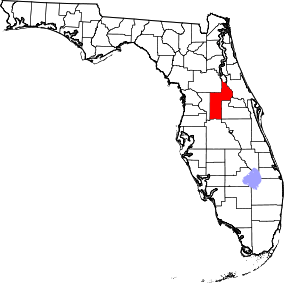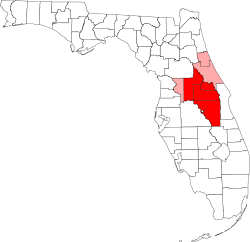Leesburg, Florida
| Leesburg, Florida | |
|---|---|
| City | |
| City of Leesburg | |
 Leesburg City Hall | |
| Motto(s): "The Lakefront City" | |
 Location in Lake County and the state of Florida | |
| Coordinates: 28°48′38″N 81°53′0″W / 28.81056°N 81.88333°WCoordinates: 28°48′38″N 81°53′0″W / 28.81056°N 81.88333°W | |
| Country |
|
| State |
|
| County |
|
| Government | |
| • City Manager | Al Minner |
| • Deputy City Manager | Michael Rankin |
| Area[1] | |
| • Total | 41.87 sq mi (108.43 km2) |
| • Land | 31.78 sq mi (82.32 km2) |
| • Water | 10.08 sq mi (26.12 km2) |
| Elevation | 95 ft (29 m) |
| Population (2010) | |
| • Total | 20,117 |
| • Estimate (2016)[2] | 22,419 |
| • Density | 705.38/sq mi (272.35/km2) |
| Time zone | UTC-5 (Eastern (EST)) |
| • Summer (DST) | UTC-4 (EDT) |
| ZIP codes | 34748, 34788 |
| Area code(s) | 352 |
| FIPS code | 12-39875[3] |
| GNIS feature ID | 0285440[4] |
Leesburg is a city in Lake County, Florida, United States. The population was 15,956 at the 2000 census. As of 2005, the population recorded by the U.S. Census Bureau was 19,086.[5]
Leesburg is in central Florida, between Lake Harris and Lake Griffin, at the head of the Oklawaha River system. It is part of the Orlando–Kissimmee–Sanford Metropolitan Statistical Area.
Leesburg is the home of Lake-Sumter State College (LSSC), which also has campuses in Clermont and Sumterville, Florida. It is also the home of Beacon College.
History

Leesburg was first settled in 1857 by Evander McIver Lee. Several of his brothers followed him to the area. One of them, Calvin Lee, was credited with giving the town its name. The city was incorporated in 1875, and was designated as the county seat of Sumter County for a time. When Lake County was formed in 1887, Tavares was designated as its seat.
In the early 20th century, Leesburg was an important center for watermelon production. In 1930, it held its first Watermelon Festival, an annual tradition that lasted for nearly 30 years. But gradually watermelon production dwindled and, for the last festival in 1957, watermelons had to be brought to the city from outside the area.
In 1938, during the Great Depression, the Franklin D. Roosevelt administration invested in infrastructure and improvement projects across the county. Its Works Progress Administration began work on the Venetian Gardens waterside park, located on the shores of Lake Harris. These canals and gardens have been a centerpiece of the community ever since.
Lake Square Mall, the city's major shopping mall, opened in 1980. On March 19, 1982, Ozzy Osbourne's guitarist Randy Rhoads, as well as the band's cook and bus driver, were killed in a plane crash at Flying Baron Estates.[6]
The citrus industry was the principal business in this area for decades, but devastating freezes in December 1983 and February 1985 persuaded growers to move their groves further south. In 1997, Leesburg Bikefest started. It has since become an annual spring tradition, with upwards of 250,000 people attending every year.
Today, most of Leesburg's growth and economic development is the result of its increasing popularity as a retirement destination. In addition, the rapid growth of nearby Orlando has resulted in demand for housing here, as many people commute to Orlando for work. In 2011 and 2017, the Leesburg High School boys' basketball team won the 4A state championship.
Geography
According to the United States Census Bureau, the city has a total area of 24.4 square miles (63 km2), of which 18.7 square miles (48 km2) is land and 5.8 square miles (15 km2) (23.65%) is water.
Several major highways pass through Leesburg, including U.S. Highway 27, U.S. Highway 441 and S.R. 44. Florida's Turnpike passes just to the south and west of Leesburg. Leesburg was on the western leg of the Dixie Highway.
Demographics
| Historical population | |||
|---|---|---|---|
| Census | Pop. | %± | |
| 1880 | 200 | — | |
| 1890 | 722 | 261.0% | |
| 1900 | 765 | 6.0% | |
| 1910 | 991 | 29.5% | |
| 1920 | 1,835 | 85.2% | |
| 1930 | 4,113 | 124.1% | |
| 1940 | 4,687 | 14.0% | |
| 1950 | 7,395 | 57.8% | |
| 1960 | 11,172 | 51.1% | |
| 1970 | 11,869 | 6.2% | |
| 1980 | 13,191 | 11.1% | |
| 1990 | 14,903 | 13.0% | |
| 2000 | 15,956 | 7.1% | |
| 2010 | 20,117 | 26.1% | |
| Est. 2016 | 22,419 | [2] | 11.4% |
| U.S. Decennial Census[7] | |||
As of the census[3] of 2000, there were 15,956 people, 6,775 households, and 4,078 families residing in the city. The population density was 854.8 inhabitants per square mile (330.0/km²). There were 7,742 housing units at an average density of 414.8 per square mile (160.1/km²). The racial makeup of the city was 66.60% White, 29.12% African American, 0.27% Native American, 1.33% Asian, 0.01% Pacific Islander, 1.26% from other races, and 1.41% from two or more races. Hispanic or Latino of any race were 4.12% of the population.
There were 6,775 households out of which 24.5% had children under the age of 18 living with them, 39.6% were married couples living together, 16.8% had a female householder with no husband present, and 39.8% were non-families. 33.9% of all households were made up of individuals and 18.1% had someone living alone who was 65 years of age or older. The average household size was 2.26 and the average family size was 2.86.
In the city, the population was spread out with 23.5% under the age of 18, 7.8% from 18 to 24, 22.7% from 25 to 44, 19.7% from 45 to 64, and 26.2% who were 65 years of age or older. The median age was 42 years. For every 100 females, there were 83.8 males. For every 100 females age 18 and over, there were 78.2 males.
The median income for a household in the city was $25,988, and the median income for a family was $33,250. Males had a median income of $25,840 versus $20,888 for females. The per capita income for the city was $15,762. About 16.2% of families and 19.8% of the population were below the poverty line, including 35.3% of those under age 18 and 11.9% of those age 65 or over.
Education
Lake County Schools operates public primary and secondary schools:
- Leesburg High School
- Oak Park Middle School
- Leesburg Elementary School
Tertiary institutions:
 Leesburg Elementary School
Leesburg Elementary School Oak Park Middle School
Oak Park Middle School
Sports
Baseball
From 1922 to 1924, the city's Cooke Field was used by the Philadelphia Phillies for their spring training sessions.[8] On March 14, 1923, the stadium was used for the site of an exhibition game between the Phillies and the St. Louis Cardinals.[9] In 1936, the city built the Ballpark at Venetian Gardens, which was used by several minor league baseball clubs that played in the Florida State League from 1937 to 1968. The city won league titles in 1941 and 1946.[10] Since 2007, the city has been the home of the Leesburg Lightning, a wood-bat collegiate summer baseball team in the Florida Collegiate Summer League.
Shooting exhibitions
During the 1920s, sharpshooter Annie Oakley, who had a residence in Leesburg, performed shooting exhibitions at Cooke Field, including one for the Philadelphia Phillies.[11]
Notable people
- Dan Hinote, St. Louis Blues center was born in Leesburg.
- Austin "Red" Robbins, ABA player, was born in Leesburg
- Abe Anellis, a food microbiologist who worked for the U.S. Army and was born in Mahilyow, Belarus, retired to Leesburg in 1977, where he lived until his death.
- Rear Admiral George Stephen Morrison grew up in Leesburg and was the father of Jim Morrison of The Doors
- Bill McBride, former candidate for Florida governor, husband of former Florida CFO Alex Sink, grew up in Leesburg.
- David McCheyne Newell, author, journalist
- Johnny Thunder, singer
- Susan Harrison, actress
- Jonathan Hay, music producer, publicist
- Robert S Singleton, American engineer and scientist, graduated from Leesburg High School
Villages expansion
In spring 2017, the Holding Company of the Villages planned to acquire 2,600 acres north and south of County Road 470 along the east side of Florida’s Turnpike for future development. The deal with the mega-retirement community must pass due diligence by the Leesburg City Commission. Age-restricted zoning ordinance changes have already been approved by the Leesburg Planning Commission (with the city commission giving final approval).[12] The initial plans call for building approximately 4,500 homes and some commercial development.[13]
Gallery
 Leesburg Post Office
Leesburg Post Office
References
- ↑ "2016 U.S. Gazetteer Files". United States Census Bureau. Retrieved Jul 7, 2017.
- 1 2 "Population and Housing Unit Estimates". Retrieved June 9, 2017.
- 1 2 "American FactFinder". United States Census Bureau. Retrieved 2008-01-31.
- ↑ "US Board on Geographic Names". United States Geological Survey. 2007-10-25. Retrieved 2008-01-31.
- ↑ "Archived copy". Archived from the original on 2007-07-22. Retrieved 2013-08-23.
- ↑
- ↑ "Census of Population and Housing". Census.gov. Retrieved June 4, 2015.
- ↑ Reed, Rick (August 29, 2014). "Baseball played an important role in early Leesburg". Daily Commercial. Archived from the original on April 23, 2015. Retrieved February 9, 2017.
- ↑ Reed, Rick (October 3, 2014). "Some of baseball's best got their start in Leesburg". Daily Commercial. Archived from the original on April 23, 2015. Retrieved February 9, 2017.
- ↑ BR Minors
- ↑ Kasper, Shirl (1992). Annie Oakley. University of Oklahoma Press. pp. 231–232. ISBN 0806124180.
- ↑ Corder, David R. (2017-12-30). "Villages Expansion Plans Energize Sumter Economy". The Villages Daily Sun. Retrieved 2017-12-30.
- ↑ Stanfield, Frank (2018-01-18). "The Villages expansion deal nears completion". Daily Commercial. Retrieved 2018-01-19.
External links
| Wikimedia Commons has media related to Leesburg, Florida. |



